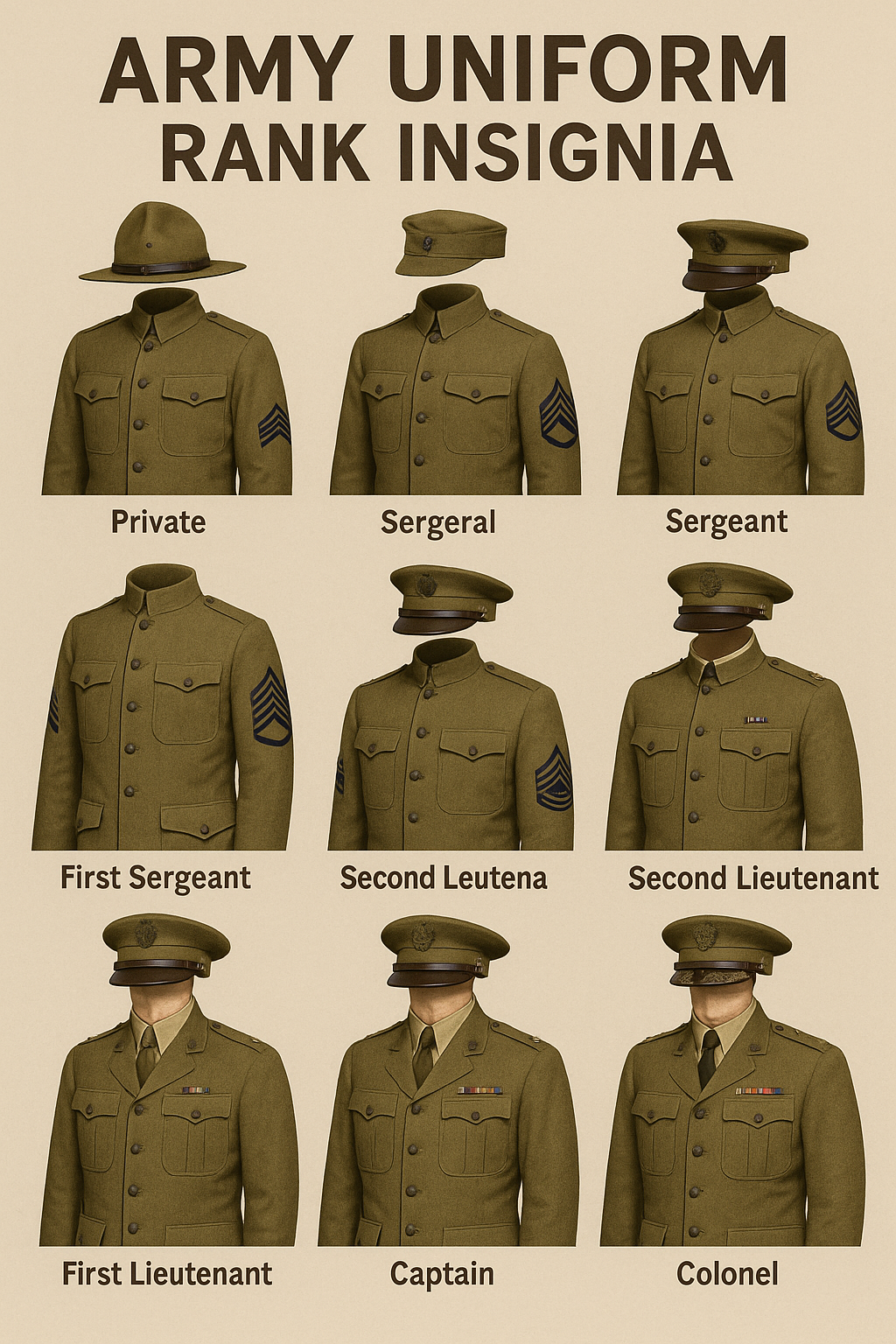
Unlocking the Secrets of WWI Army Uniform Rank Insignia: A Complete Guide for History Buffs
Published on Oct 01, 2025
Introduction: Did You Know That Uniform Rank Was Life or Death in WWI?
In the chaos of the trenches during World War I, identifying a soldier’s army uniform rank wasn’t just a matter of pride—it could literally save a life. A misread insignia could cost a chain of command or disrupt crucial battlefield communication. This subtle detail of WWI uniforms holds enormous value for collectors, historians, reenactors, and war buffs.
Today, understanding these historic military uniforms isn’t just about admiration. Whether you're building a collection, writing a screenplay, or preparing for a reenactment, grasping the nuances of WWI army uniform rank insignia is essential. This guide will walk you through everything—from identifying badges to decoding army headgear—plus real-world examples, current trends, and actionable steps to avoid common mistakes.
What Is Army Uniform Rank Insignia—and Why It Matters
Rank insignia is a visual system used to denote hierarchy within military structures. During WWI, the US Army (and many others) used chevrons, piping, shoulder straps, and badges to indicate a soldier’s rank, from private to general.
Why You Should Care:
- Historical Accuracy: Crucial for reenactments, documentaries, or dioramas.
- Collectible Value: Misidentifying a badge can cost you hundreds of dollars.
- Understanding Context: Uniforms reveal a lot about command structure and soldier roles.
H2: Actionable Steps to Identify WWI Army Uniform Rank Insignia
Step 1: Learn the Basic Rank Structure
WWI US Army ranks included:
- Enlisted Ranks: Private, Corporal, Sergeant, First Sergeant, Sergeant Major
- Warrant Officers: Rare during WWI, mostly in technical roles
- Commissioned Officers: 2nd Lieutenant up to General
Insignia placement was often on:
- Upper sleeves (chevrons)
- Collars or shoulder straps
- Cuffs (especially for officers in dress uniforms)
Step 2: Understand Color and Material Usage
- Chevrons: Often gold or khaki on wool or cotton uniforms
- Officer Insignia: Typically brass or embroidered
- Unit Colors: Infantry (light blue), Artillery (red), Cavalry (yellow)
🔍 Example: A corporal in the infantry would wear two light blue chevrons on each sleeve of their service coat.
Step 3: Use Reference Materials
Keep a copy of official WWI military guides, like:
- "Uniforms of the United States Army 1774–1889"
- National Archives Military Rank Charts
- Collector’s Guides specific to WWI or branch-specific details
H2: Common Pitfalls in Identifying Army Uniform Rank
1. Confusing WWI with WWII Uniforms
Many collectors mistakenly buy WWII insignia, thinking it’s WWI. While similar in design, WWI materials and stitching methods differ.
Actionable Tip: Check for corporal king—WWI chevrons often had a coarse, wool-like material.
2. Overlooking Modified Uniforms
Field repairs and makeshift uniforms during WWI were common. Some soldiers even modified their army service uniform tie or jacket to improve fit or comfort.
Solution: Cross-check with period photographs and avoid assuming every variation is fake.
3. Ignoring Headgear
Army service uniform headgear, such as the "Montana Peak" campaign hat, sometimes included branch or rank indicators.
Watch for:
- Colored cords (yellow for Cavalry, red for Artillery)
- Brass badges on the front
- Officer cap insignia (eagles, stars)
H2: Decoding Uniform Accessories: Headgear, Ties, and Badges
Army Service Uniform Headgear
The most iconic hats included:
- Montana Peak Hat (campaign hat): Worn by enlisted men and officers
- Overseas Cap: Popular with American Expeditionary Forces (AEF)
- Visor Cap: Typically worn by officers
🎖 Pro Tip: Officer caps often had gold braid around the visor—a clear marker of rank.
Army Service Uniform Tie
The tie was usually:
- Khaki-colored wool
- Narrow and short
- Worn tucked under the tunic for a neat appearance
While seemingly minor, differences in the army service uniform tie style can help identify specific regiments or periods.
US Army Badges
Badges were used to mark:
- Marksmanship: Expert Rifleman, Sharpshooter
- Service: Overseas Service Bars, Wound Chevron
- Special Roles: Signal Corps, Medics, Engineers
Marine Service Alphas Regulations Note: While not directly part of the WWI Army, comparing Marine Service Alphas regulations can help collectors differentiate between similar-looking uniforms from different branches.
H2: How to Preserve and Display WWI Uniforms and Insignia
Proper Storage
- Use acid-free boxes and archival tissue paper
- Avoid moisture and direct sunlight
- Keep badges and insignia separate to prevent material bleed
Display Options
- Shadow boxes with UV-protective glass
- Mannequins for full uniforms
- Framed boards for loose US Army badges
Pitfall to Avoid: Using Modern Stitching for Repairs
If you must repair, match the thread colour and type to period-authentic materials. Modern thread glows under UV light, ruining authenticity.
H2: Current Trends in WWI Uniform Collecting
Growing Interest in Officer Insignia
Collectors are increasingly seeking out:
- Colonel and General insignia
- Personalized field jackets
- Custom modifications from AEF officers
Reenactment Accuracy
Groups are putting more emphasis on:
- Authentic reproduction of army service uniform headgear
- Period-correct army service uniform ties
- Correct placement of insignia per rank and branch
📈 Trend: TikTok and YouTube history channels are boosting interest in WWI uniforms, especially among younger collectors.
Conclusion: Mastering Army Uniform Rank Is Your Key to Historical Insight
Understanding army uniform rank during WWI opens doors to deeper historical knowledge, accurate collecting, and meaningful storytelling. Whether you’re a reenactor, collector, or curious history fan, learning to decode insignia, headgear, and badges will elevate your passion and help preserve military heritage.
Final Tips:
- Don’t skip small details like ties and buttons—they matter!
- Always verify authenticity through multiple sources.
- Join forums or reenactment groups to learn from experts.
